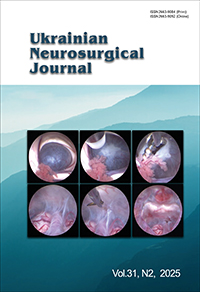Unlocking relief: Lower half laminectomy for lumbar disc herniation under spinal anesthesia: An institutional perspective
DOI:
https://doi.org/10.25305/unj.325120Keywords:
limited laminectomy, open decompression, disc herniationAbstract
Lumbar disc herniation is a prevalent spinal condition characterized by the displacement of intervertebral disc material leading to back pain and neuropathies. Surgical intervention, including decompressive laminectomy, is often recommended for patients who fail to respond to conservative treatment. The procedure of unilateral or bilateral lower half laminectomy, with or without disc herniation removal, has been described as an effective surgical technique for treating lumbar disc herniations.
Purpose: The aim of the study was the assessment of outcomes including complications in patients undergoing limited laminectomy with discectomy.
Material and methods: A total of 188 patients over a period from May 2022 till May 2024 were prospectively studied.Outcomes were assessed using Odom’s criteria, including complication, recovery status at subsequent follow up at 1 and 3 months.
Results: Out of 188 patients, single disc herniations were seen in 155 while 2-level disc were seen in 33 cases. Among these, L5-S1 level herniation was most common , and in multi-disc herniation, L5-L5,L5-S1 levels were common. Most patients presented with radicular pain(127) followed by motor deficits or sensory deficits. Post operative recovery status was classified as excellent in the majority of cases (121 out of 188) with very less in fair and none in poor category. The recovery was gradually towards better grades in subsequent follow-ups. Duration of surgery was less than 1 hour in about 90% cases (16 out of 188).
Conclusions: All cases were done under spinal anaesthesia. Adequate surgical exposure was obtained. The technique allowed for early mobilization, reduced hospital stay apart from a shorter learning curve requirement as compared to microscopic or endoscopic procedures. During discectomy the thickened ligamentum flavum (causing canal stenosis/narrowing) can also be dealt in single procedure. This procedure could be a safer alternative to the newer modalities of minimally invasive surgeries for lumbar decompression.
References
1. Al Qaraghli MI, De Jesus O. Lumbar Disc Herniation. In: StatPearls. Treasure Island (FL): StatPearls Publishing; 2024.https://www.ncbi.nlm.nih.gov/books/NBK560878/
2. Finneran MM, Naik A, Hawkins JC, Nardone EM. Minimally invasive bilateral decompressive lumbar laminectomy with unilateral approach: patient series. J Neurosurg Case Lessons. 2022 Feb 14;3(7):CASE21676. [CrossRef] [PubMed] [PubMed Central]
3. Zhao Z, Gu J. Open surgery in the era of minimally invasive surgery. Chin J Cancer Res. 2022 Feb 28;34(1):63-65. [CrossRef] [PubMed] [PubMed Central]
4. Estefan M, Munakomi S, Camino Willhuber GO. Laminectomy. In: StatPearls. Treasure Island (FL): StatPearls Publishing; 2024 Jan-. https://www.ncbi.nlm.nih.gov/books/NBK542274/
5. McCulloch JA. Focus issue on lumbar disc herniation: macro- and microdiscectomy. Spine (Phila Pa 1976). 1996 Dec 15;21(24 Suppl):45S-56S. [CrossRef] [PubMed]
6. Gadjradj PS, Rubinstein SM, Peul WC, Depauw PR, Vleggeert-Lankamp CL, Seiger A, van Susante JL, de Boer MR, van Tulder MW, Harhangi BS. Full endoscopic versus open discectomy for sciatica: randomised controlled non-inferiority trial. BMJ. 2022 Feb 21;376:e065846. [CrossRef] [PubMed] [PubMed Central]
7. Gadjradj PS, Harhangi BS, Amelink J, van Susante J, Kamper S, van Tulder M, Peul WC, Vleggeert-Lankamp C, Rubinstein SM. Percutaneous Transforaminal Endoscopic Discectomy Versus Open Microdiscectomy for Lumbar Disc Herniation: A Systematic Review and Meta-analysis. Spine (Phila Pa 1976). 2021 Apr 15;46(8):538-549. [CrossRef] [PubMed] [PubMed Central]
8. Calikoglu C, Cakir M. Open Discectomy vs. Microdiscectomy: Results from 519 Patients Operated for Lumbar Disc. Herniation. Eurasian J Med. 2018 Oct;50(3):178-181. [CrossRef] [PubMed] [PubMed Central]
9. Gargiulo DA, Mitchell SJ, Sheridan J, Short TG, Swift S, Torrie J, Webster CS, Merry AF. Microbiological Contamination of Drugs during Their Administration for Anesthesia in the Operating Room. Anesthesiology. 2016 Apr;124(4):785-94. [CrossRef] [PubMed]
10. Kulkarni AG, Bassi A, Dhruv A. Microendoscopic lumbar discectomy: Technique and results of 188 cases. Indian J Orthop. 2014 Jan;48(1):81-7. [CrossRef] [PubMed] [PubMed Central]
11. Tao XZ, Jing L, Li JH. Therapeutic effect of transforaminal endoscopic spine system in the treatment of prolapse of lumbar intervertebral disc. Eur Rev Med Pharmacol Sci. 2018 Jul;22(1 Suppl):103-110. [CrossRef] [PubMed]
12. Xu G, Zhang C, Zhu K, Bao Z, Zhou P, Li X. Endoscopic removal of nucleus pulposus of intervertebral disc on lumbar intervertebral disc protrusion and the influence on inflammatory factors and immune function. Exp Ther Med. 2020 Jan;19(1):301-307. [CrossRef] [PubMed] [PubMed Central]
Published
How to Cite
Issue
Section
License
Copyright (c) 2025 Jiwesh Kumar, Kaushik Roy, Krishnendu Sardar, Anita Singh

This work is licensed under a Creative Commons Attribution 4.0 International License.
Ukrainian Neurosurgical Journal abides by the CREATIVE COMMONS copyright rights and permissions for open access journals.
Authors, who are published in this Journal, agree to the following conditions:
1. The authors reserve the right to authorship of the work and pass the first publication right of this work to the Journal under the terms of Creative Commons Attribution License, which allows others to freely distribute the published research with the obligatory reference to the authors of the original work and the first publication of the work in this Journal.
2. The authors have the right to conclude separate supplement agreements that relate to non-exclusive work distribution in the form of which it has been published by the Journal (for example, to upload the work to the online storage of the Journal or publish it as part of a monograph), provided that the reference to the first publication of the work in this Journal is included.









